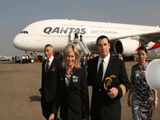Qantas A380 flight ‘saves carbon’
 Qantas has claimed that its inaugural A380
Qantas has claimed that its inaugural A380
service between Los Angeles and Melbourne had saved thousands of kilograms
of carbon emissions under a joint initiative with Airservices Australia and
the Asia and South Pacific Initiative to Reduce Emissions group (ASPIRE).ASPIRE involves Airservices Australia, the United States Federal Aviation
Administration and Airways New Zealand working with airlines on a series of
demonstration flights to highlight the potential for reducing emissions on
trans-Pacific flights.
Under the ASPIRE initiative, Qantas’ first A380, operating as QF94 used
electrical power on the ground in Los Angeles rather than running its
auxiliary power unit, and was given:
- priority clearance from air traffic control for taxiing and departure;
- a priority departure route out of Los Angeles and unimpeded climb through to cruise altitude, allowing it to reach its optimum cruise altitude as quickly and efficiently as possible;
- a user preferred route for the most efficient path taking into account winds and aircraft weight and;
- two real time updates of current weather and wind conditions that allowed the flight crew to modify their flight path.
Qantas Chief Risk Officer, Mr Rob Kella, said the flight demonstrated that
a high level of cooperation between all sectors of the aviation industry
could achieve world’s best practice efficiency.
“Airlines like Qantas are investing billions of dollars in the most fuel
efficient aircraft and in reducing the environmental impact of their
operations,” Mr Kella said.
“By working with key industry partners like Airservices Australia, we can
fly the most fuel efficient flight paths which, if translated across our
fleet, would deliver significant reductions in fuel burn and reduced impact
on the environment.”
ADVERTISEMENT
Airservices Australia Chief Executive Officer, Mr Greg Russell, said the
demonstration flight showed that with the development of new technologies
and advanced air traffic management techniques, aircraft fuel efficiency
could be further improved.
“Today there are many examples of new aviation technologies offering
significant environmental benefits, and we have invested heavily in a
number of research and development projects to further our efforts in this
area,” Mr Russell said.
Mr Kella said The Qantas Group had a well-established fuel conservation
program and challenging improvement targets that included a 25 per cent
improved fuel efficiency target by 2020.
“Since 2000, the Qantas Group has invested an average of $2 billion per
annum in upgrading its international and domestic fleets,” he said.
“With the introduction of the A380, and other new generation aircraft, we
will be able to deliver significant improvements in emissions efficiency
and noise.
“Partnerships such as ASPIRE will allow us to work towards a more
sustainable and fuel efficient future.”
Calculations and details of today’s Qantas ASPIRE flight will be released
via the ASPIRE website, www.aspire-green.com
——-

